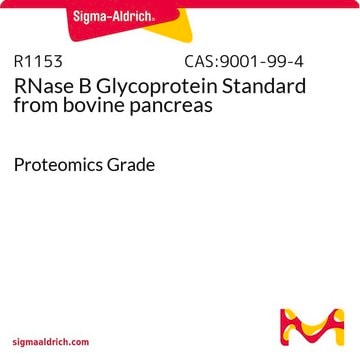A4781
Asialofetuin from fetal calf serum
Type I (Sigma designation)
Sinónimos:
Asialofetuin
About This Item
Productos recomendados
biological source
bovine (calf) serum
Quality Level
type
Type I (Sigma designation)
form
powder
impurities
salt, essentially free
≤0.5% N-acetylneuraminic acid
solubility
0.85% sodium chloride: soluble 1 mg/mL
storage temp.
2-8°C
¿Está buscando productos similares? Visita Guía de comparación de productos
General description
Application
- to quantitate the plant Ricin toxin′s B subunit (RTB) lectin activity in β-phaseolin signal peptide (P)–proinsulin gene (INS)–RTB plants by enzyme-linked immunosorbent assay (ELISA)
- quantitate VP7:RTB fusion protein in transformed potato tissues by ELISA
- as a glycoprotein substrate to measure the receptor-binding activity of recombinant RTB and NSP490–RTB fusion proteins
- to study the nature of the interaction between ferritin and the placenta
Biochem/physiol Actions
Preparation Note
Storage Class
11 - Combustible Solids
wgk_germany
WGK 3
flash_point_f
Not applicable
flash_point_c
Not applicable
ppe
Eyeshields, Gloves, type N95 (US)
Certificados de análisis (COA)
Busque Certificados de análisis (COA) introduciendo el número de lote del producto. Los números de lote se encuentran en la etiqueta del producto después de las palabras «Lot» o «Batch»
¿Ya tiene este producto?
Encuentre la documentación para los productos que ha comprado recientemente en la Biblioteca de documentos.
Los clientes también vieron
Nuestro equipo de científicos tiene experiencia en todas las áreas de investigación: Ciencias de la vida, Ciencia de los materiales, Síntesis química, Cromatografía, Analítica y muchas otras.
Póngase en contacto con el Servicio técnico













